Cultivating the Evolution of Rice
INSIDE ACADEMIA
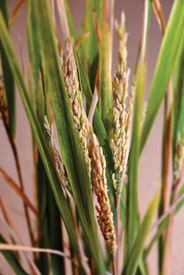 Humankind would probably not exist were it not for cultivated grasses, whose edible seeds are known as grains or cereals. Wheat, maize, rice, and other cereals are the basis for civilization, and rice is the most popular grain in the world: It is cultivated in 113 countries, and a primary food source for more than half of the world’s population. In addition, it is the only major crop grown exclusively for human consumption and feeds more people around the world than any other crop. For these reasons, rice is an important crop worldwide, influencing diets, cultures, and economies. Ensuring the survival and success of the world’s most important crop requires more than just planting seeds and adding water. And perhaps no one knows that better than researchers at the University of Arkansas Rice Processing Program, who for more than two decades have engaged in research to enhance the quality and yield of rice as well as the efficiency and effectiveness of rice processing. It is the only U.S.-based program conducting basic and applied research to improve postharvest/preproduction practices for rice.
Humankind would probably not exist were it not for cultivated grasses, whose edible seeds are known as grains or cereals. Wheat, maize, rice, and other cereals are the basis for civilization, and rice is the most popular grain in the world: It is cultivated in 113 countries, and a primary food source for more than half of the world’s population. In addition, it is the only major crop grown exclusively for human consumption and feeds more people around the world than any other crop. For these reasons, rice is an important crop worldwide, influencing diets, cultures, and economies. Ensuring the survival and success of the world’s most important crop requires more than just planting seeds and adding water. And perhaps no one knows that better than researchers at the University of Arkansas Rice Processing Program, who for more than two decades have engaged in research to enhance the quality and yield of rice as well as the efficiency and effectiveness of rice processing. It is the only U.S.-based program conducting basic and applied research to improve postharvest/preproduction practices for rice.
“The University of Arkansas Rice Processing Program was created for a couple of reasons: There was a lot of research that was needed to bridge some gaps between drying and milling and end-use processing,” says Terry Siebenmorgen, a professor in the food science department at the University of Arkansas and director of the Rice Processing Program. “We [also] saw a need to pull the industry together, and that’s what we did, trying to get support across the industry and develop a program that would be a focus for rice processing research—not just for drying and milling but all the way through end-use processing and sensory analysis.” The program was created in 1993, and since then, Siebenmorgen and a team of researchers have been investigating better ways to increase rice yield; dry, store, and mill rice; improve rice quality; prevent food loss and food safety issues; and develop new rice products. Each of the faculty members involved in the Rice Processing Program has a particular expertise along the continuum of producing and processing rice from farm to fork.
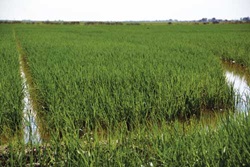 Growing and Harvesting Rice
Growing and Harvesting Rice
The seed (grain) of the grass species Oryza sativa and Oryza glaberrima, rice was introduced to the United States during the early colonial period and eventually became an important crop in the Carolinas. Today, the top rice-producing states are Arkansas, California, Louisiana, Missouri, Mississippi, and Texas. “Arkansas leads in the production of rice; we now produce more than half the U.S. rice crop,” Siebenmorgen asserts. “There are probably 20 or more cultivars of rice that are grown in Arkansas,” adds Paul Counce, a professor in the department of crop, soil, and environmental sciences at the University of Arkansas who works with the Rice Processing Program and is a rice physiologist at the university’s Rice Research and Extension Center. Rice plants can grow to a height of about three feet. Each stalk ends with a panicle that contains grains surrounded by bracts. It is usually planted in April through May and harvested from mid-August through September. While flooded fields may seem like the normal environment for growing rice, optimal conditions for growing rice can vary depending on the cultivar of rice. “Rice is a semiaquatic plant,” Counce explains. “Rice can spend almost all of its lifecycle in a flooded situation. For instance, we can grow rice by seeding it on top of the soil and flood it, and it will complete its entire lifecycle from seed to mature grain, growing in that flood.” In fact, a characteristic that distinguishes rice from other cultivated grasses is that each stem has air chambers that carry oxygen from the leaves down to the roots; this allows the plant to survive during flooding. “All the other grains—corn, wheat, barley, and so on—will die if they’re flooded; rice won’t,” Counce declares. Because rice is semiaquatic, it can also grow in drier conditions.
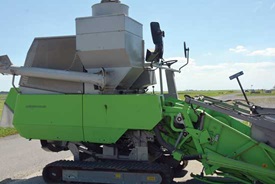 In the United States, rice is grown in fields containing systems of levees that keep an even distribution of water on the crop when the fields are flooded. Farmers flood rice crops once the plants emerge from the soil because most varieties of rice grow better and produce higher yields in flooded soil. Temperature is also a factor for rice production. “The optimal conditions for growing rice vary slightly for each stage of development. But in general, rice grows best in temperatures from 70°F to 100°F. The optimal [temperature] for fertilization is about 87°F or 88°F. It will germinate in temperatures that are very low, close to or anything above freezing, but then it just germinates very slowly,” Counce says. “So different stages are more sensitive. Reproductive rice is very sensitive to temperature, and if temperatures drop below about 57°F, then the male gametes won’t form and the rice will be completely blank because there are no male gametes to fertilize the female gametes,” Counce says. Once rice reaches maturity, the fields are drained and the rice is harvested using modern combines that are similar to those used for harvesting other grains. “Rice is harvested very similarly to wheat, rye, and barley, using much of the same harvesting technology,” Counce says. “The flood is removed, and the soil is allowed to dry to a degree. And then the combine goes over the field and threshes the field.” Rice can also be harvested manually with a scythe or other cutting tool. “Rice is one of the more challenging crops to harvest,” Siebenmorgen says. “The reason for that is, in some instances because of the flooded conditions, sometimes the fields are a little wet. They are also a little prone sometimes to early season hurricanes that can lodge the crop, so the crop sometimes lies over and it’s hard to pick it up.”
In the United States, rice is grown in fields containing systems of levees that keep an even distribution of water on the crop when the fields are flooded. Farmers flood rice crops once the plants emerge from the soil because most varieties of rice grow better and produce higher yields in flooded soil. Temperature is also a factor for rice production. “The optimal conditions for growing rice vary slightly for each stage of development. But in general, rice grows best in temperatures from 70°F to 100°F. The optimal [temperature] for fertilization is about 87°F or 88°F. It will germinate in temperatures that are very low, close to or anything above freezing, but then it just germinates very slowly,” Counce says. “So different stages are more sensitive. Reproductive rice is very sensitive to temperature, and if temperatures drop below about 57°F, then the male gametes won’t form and the rice will be completely blank because there are no male gametes to fertilize the female gametes,” Counce says. Once rice reaches maturity, the fields are drained and the rice is harvested using modern combines that are similar to those used for harvesting other grains. “Rice is harvested very similarly to wheat, rye, and barley, using much of the same harvesting technology,” Counce says. “The flood is removed, and the soil is allowed to dry to a degree. And then the combine goes over the field and threshes the field.” Rice can also be harvested manually with a scythe or other cutting tool. “Rice is one of the more challenging crops to harvest,” Siebenmorgen says. “The reason for that is, in some instances because of the flooded conditions, sometimes the fields are a little wet. They are also a little prone sometimes to early season hurricanes that can lodge the crop, so the crop sometimes lies over and it’s hard to pick it up.”
 Drying, Storage, and Quality Issues
Drying, Storage, and Quality Issues
“In most of Arkansas, just one rice crop can be harvested a year. In the southern parts of the United States along the Gulf Coast, there actually can be two, and the second crop is often called a ratoon crop. The growing season in most of Arkansas, Missouri, and Mississippi just isn’t long enough to get two crops,” Siebenmorgen says. Arkansas and other southern rice-producing states produce mostly long-grain rice; California produces mostly medium-grain and short-grain rice. After rice is harvested, it is dried, stored, and then milled. Drying reduces the moisture content of rice to a safe level for storage. It is the most critical step after harvesting a rice crop. When rice is harvested, its moisture content can be up to 25%. “We want to harvest rice optimally from a milling quality standpoint, depending on whether it’s medium-grain or long-grain, but for long-grain (which is most of the rice in Arkansas), we want to harvest around the 19% to 20% moisture content range,” Siebenmorgen explains. “But for long-term storage, we want to dry the rice to around 12.5% to 13%.” Hence, rice is like the Goldilocks of grains: If rice is harvested when its moisture content is too low, grains could fissure from moisture adsorption during high humidity conditions, which leads to broken rice kernels; if it’s stored when its moisture content is too high, the quality of the grains could be degraded by various factors (e.g., discoloration and mold). Both situations lead to decreased yields of head rice (i.e., intact kernels that are at least three-quarters of their original length with no discoloration or disease). It is thus very important to harvest rice before it becomes too dry and to dry rice as soon as possible after harvesting.
 Because the growth and harvest of rice occurs in a relatively short time frame, there are challenges unique to rice production, which the Rice Processing Program is working to address. “[The Rice Processing Program] has been serving the rice industry to try to answer some scientific questions … such as how to improve rice quality [and] how to improve drying efficiency,” says Griffiths Atungulu, an assistant professor in the department of food science at the University of Arkansas who also works with the Rice Processing Program. Atungulu and Siebenmorgen have been investigating ways to increase the efficiency of drying methods and address the degradation factors inherent with improperly dried and stored rice. In particular, Atungulu is exploring ways to prevent the development of mycotoxins in rice and other grains. Mycotoxins are produced by microfungi, and certain mycotoxins can have acute or chronic toxicity, resulting in birth defects, cancer, immunosuppression, kidney or liver failure, and so on. Because the postharvest methods utilized in the United States are much more sophisticated than those in developing countries, incidences of microfungi and mycotoxins contaminating U.S. rice are few and far between—but they can still occur. “Of the fungi that grow on rice, one that is very stubborn and specific is Aspergillus flavus. Aspergillus flavus is known to produce aflatoxin. And depending on the conditions in which the rice is kept, [Aspergillus flavus] is liable to produce very high levels of aflatoxin or it may not product the toxin at all. [I]t boils down to how fast you can dry that rice,” Atungulu explains. “There are some isolated cases where we’ve had farmers come to us and tell us that their rice is contaminated with aflatoxin, but those are really very isolated cases in the [United States]. …We have quick drying methods. When we get [rice] from the field, we are immediately able to dry it. Most fungi will grow on rice when the moisture content is very high. … As long as we can make that moisture content very low, then the potential for that mycotoxin to occur is significantly reduced.”
Because the growth and harvest of rice occurs in a relatively short time frame, there are challenges unique to rice production, which the Rice Processing Program is working to address. “[The Rice Processing Program] has been serving the rice industry to try to answer some scientific questions … such as how to improve rice quality [and] how to improve drying efficiency,” says Griffiths Atungulu, an assistant professor in the department of food science at the University of Arkansas who also works with the Rice Processing Program. Atungulu and Siebenmorgen have been investigating ways to increase the efficiency of drying methods and address the degradation factors inherent with improperly dried and stored rice. In particular, Atungulu is exploring ways to prevent the development of mycotoxins in rice and other grains. Mycotoxins are produced by microfungi, and certain mycotoxins can have acute or chronic toxicity, resulting in birth defects, cancer, immunosuppression, kidney or liver failure, and so on. Because the postharvest methods utilized in the United States are much more sophisticated than those in developing countries, incidences of microfungi and mycotoxins contaminating U.S. rice are few and far between—but they can still occur. “Of the fungi that grow on rice, one that is very stubborn and specific is Aspergillus flavus. Aspergillus flavus is known to produce aflatoxin. And depending on the conditions in which the rice is kept, [Aspergillus flavus] is liable to produce very high levels of aflatoxin or it may not product the toxin at all. [I]t boils down to how fast you can dry that rice,” Atungulu explains. “There are some isolated cases where we’ve had farmers come to us and tell us that their rice is contaminated with aflatoxin, but those are really very isolated cases in the [United States]. …We have quick drying methods. When we get [rice] from the field, we are immediately able to dry it. Most fungi will grow on rice when the moisture content is very high. … As long as we can make that moisture content very low, then the potential for that mycotoxin to occur is significantly reduced.”
In the United States, there are primarily two methods of drying rice. “About 20% of the rice here in Arkansas is dried in bin dryers on the farms where the rice was produced. In that technique, large metal bins are filled to a certain depth and then fans blow outside air through the rice,” Siebenmorgen says. “It’s a fairly slow process, but it’s a fairly gentle process. The other 80% of the rice in Arkansas is dried in large commercial dryers. And these dryers, called cross-flow column dryers, are very tall structures where the rice is elevated to the top and comes down through columns. The air is heated by either natural gas or propane, and it’s moved up and across through the columns.” It takes two to three days to dry rice with commercial dryers; the process involves drying rice in alternating stages of drying in the dryer and tempering in bins so that the moisture is not all dried out at once. With on-farm bin drying, rice can take three to four weeks to dry. In developing countries, rice is dried by spreading it out on mats, pavement, tarps, or even rooftops and allowing the sun to dry the rice. Drying rice via solar energy is hardly ever used in the United States. (While it is possible to take newly harvested rice from the field and immediately process it for food, such rice would have a very high moisture content and would be difficult to mill.)
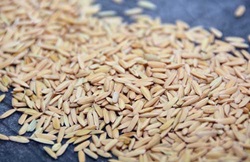 After rice is dried, it is placed in bins or large concrete silos for long-term storage. Commercial dryers help prevent the incidence of fungi, mycotoxins, and other issues in stored rice, but researchers at the Rice Processing Program are working on other methods. “We have been studying auxiliary techniques that could help us to reduce the levels of these molds,” Atungulu discloses. “One of them is using infrared heat; we have found that using infrared heating, we can reduce the levels of mold on rice.” Not only can infrared heating prevent molds from growing on rice; it can also decontaminate moldy rice because of its high heat fluxes. “When it comes to decontamination methods, infrared is one of the things that I’ve been studying for quite some time. When we dry rice using conventional methods, we use heated air, which means you have to heat the air and then the air has to heat the rice,” Atungulu explains. “The problem is the heat fluxes in heated natural air do not deactivate molds. To deactivate some of these molds, you need high heat fluxes.” However, deactivating molds in rice does not render it safe to eat. “If, for example, some rice was contaminated with a mycotoxin, and you deactivate the molds on it, the toxin is still on it. Toxins, most of the time, cannot be detoxified by just the kind of temperatures that inactivate the molds,” Atungulu clarifies. He and his research team have also discovered ways to eliminate other problems that facilitate mold growth during the drying and storing of rice, such as microwave heating and cooling techniques. “We’ve found that microwave heating can also significantly reduce the levels of mold in rice. [And] just keeping that grain cool by using some cooling technologies has also been proven to show significant effectiveness in reducing the levels of mold and toxin formation,” Atungulu states. The industry practice of fumigating rice storage units helps eliminate insects in stored rice, which is beneficial because “insects have a way of digging into the rice that makes it easy for molds to grow,” Atungulu adds.
After rice is dried, it is placed in bins or large concrete silos for long-term storage. Commercial dryers help prevent the incidence of fungi, mycotoxins, and other issues in stored rice, but researchers at the Rice Processing Program are working on other methods. “We have been studying auxiliary techniques that could help us to reduce the levels of these molds,” Atungulu discloses. “One of them is using infrared heat; we have found that using infrared heating, we can reduce the levels of mold on rice.” Not only can infrared heating prevent molds from growing on rice; it can also decontaminate moldy rice because of its high heat fluxes. “When it comes to decontamination methods, infrared is one of the things that I’ve been studying for quite some time. When we dry rice using conventional methods, we use heated air, which means you have to heat the air and then the air has to heat the rice,” Atungulu explains. “The problem is the heat fluxes in heated natural air do not deactivate molds. To deactivate some of these molds, you need high heat fluxes.” However, deactivating molds in rice does not render it safe to eat. “If, for example, some rice was contaminated with a mycotoxin, and you deactivate the molds on it, the toxin is still on it. Toxins, most of the time, cannot be detoxified by just the kind of temperatures that inactivate the molds,” Atungulu clarifies. He and his research team have also discovered ways to eliminate other problems that facilitate mold growth during the drying and storing of rice, such as microwave heating and cooling techniques. “We’ve found that microwave heating can also significantly reduce the levels of mold in rice. [And] just keeping that grain cool by using some cooling technologies has also been proven to show significant effectiveness in reducing the levels of mold and toxin formation,” Atungulu states. The industry practice of fumigating rice storage units helps eliminate insects in stored rice, which is beneficial because “insects have a way of digging into the rice that makes it easy for molds to grow,” Atungulu adds.
Milling and Fortifying
 The drying and storing of rice ready it for the final step in preparing rice for end use: milling. The milling process for rice is very different from that of other cereal grains. First the rice is passed through sheller machines to remove rice hulls, which are inedible. At this point, the rice is now categorized as brown rice, which has bran layers and germ intact. Brown rice is then further milled by machines that apply pressure/abrasion to remove the bran layers and germ to produce polished kernels of white rice. “At that point, we have what’s called milled rice, and that product contains both intact kernels and broken [kernels],” Siebenmorgen points out. “There is another stage that we have to go through: the mechanical separation of the intact kernels from the broken [kernels]. The broken [kernels] are used for a variety of things, but generally they’re used for flour. And there is increasing demand for rice flour because it’s a gluten-free product. … The head rice is packaged and used for various things or it goes to cereal plants.” Most of the rice produced in Arkansas and other rice-producing states is processed into white rice, and most people around the world consume white rice even though “brown rice is nutritionally superior to white rice because the bran layer, which we remove to turn brown rice into white rice, contains a lot of vitamins and minerals,” says Ya-Jane Wang, another member of the Rice Processing Program team and a professor in the University of Arkansas’s food science department. For this reason, white rice is fortified in six countries, including the United States—where white rice is fortified with iron, niacin, thiamin, and folic acid.
The drying and storing of rice ready it for the final step in preparing rice for end use: milling. The milling process for rice is very different from that of other cereal grains. First the rice is passed through sheller machines to remove rice hulls, which are inedible. At this point, the rice is now categorized as brown rice, which has bran layers and germ intact. Brown rice is then further milled by machines that apply pressure/abrasion to remove the bran layers and germ to produce polished kernels of white rice. “At that point, we have what’s called milled rice, and that product contains both intact kernels and broken [kernels],” Siebenmorgen points out. “There is another stage that we have to go through: the mechanical separation of the intact kernels from the broken [kernels]. The broken [kernels] are used for a variety of things, but generally they’re used for flour. And there is increasing demand for rice flour because it’s a gluten-free product. … The head rice is packaged and used for various things or it goes to cereal plants.” Most of the rice produced in Arkansas and other rice-producing states is processed into white rice, and most people around the world consume white rice even though “brown rice is nutritionally superior to white rice because the bran layer, which we remove to turn brown rice into white rice, contains a lot of vitamins and minerals,” says Ya-Jane Wang, another member of the Rice Processing Program team and a professor in the University of Arkansas’s food science department. For this reason, white rice is fortified in six countries, including the United States—where white rice is fortified with iron, niacin, thiamin, and folic acid.
Fortification is the deliberate addition of essential micronutrients (vitamins, minerals, trace elements) to food to improve the nutritional quality of the food supply. “The reason for rice fortification is to add micronutrients to rice that are limited in the human population so that when people consume rice, they’re actually going to obtain micronutrients that they need,” Siebenmorgen says. There are various methods for fortifying rice, but dusting or spraying with a micronutrient powder seems to be the most common. This process, however, is very expensive and developing countries cannot always afford to do this. Wang is investigating more effective and efficient ways to fortify rice. “Rice in the United States is fortified, but just by dusting. If you don’t wash your rice before cooking it, the nutrients are there,” Wang explains. “But if you wash rice before you cook it or cook it in excess water, you don’t get those nutrients. People in Asian and other countries always wash rice. They do it to wash away any odor or oxidized material. That’s why the way rice is fortified is not effective.” Wang believes that one way to improve the effectiveness of rice fortification is parboiling.
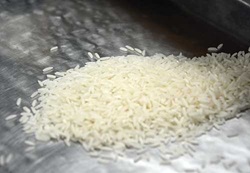 The common way to process rice is to dry it, remove the hull, and polish the rice until it becomes white. However, parboiling is another way to process rice, and it begins before the hull is removed. During parboiling, rice caryopses (hull, rice, bran, and germ) are soaked, steamed, and dried; the hulls are removed afterward. Parboiling enables rice to absorb nutrients and alters the structure of the starch, thereby changing the texture of the rice. It also reduces the number of broken kernels and thus increases head rice yield. “Parboiled rice is much higher in nutrition than regular milled rice,” Wang declares. “Because most people do not eat brown rice, only the people who eat parboiled rice get the benefit of the bran layer. All of the vitamins are in the bran layer of rice.” During parboiling, the nutrients of the bran layer migrate into the endosperm, which is what people consume when they eat rice. “Some time ago in history, medical researchers noticed that people who ate parboiled rice did not have beriberi while people who ate milled rice did. They figured out that parboiled rice is much higher in B vitamins,” Wang says. She sees parboiling as a way to fortify rice with other essential micronutrients that are either not naturally present in rice or present in insignificant amounts. This method of fortification is especially important for developing countries where rice is the main or only source of nutrition. “Rice is not a superfood; you don’t get all the nutrients you need from rice. For regions where rice is the main source of energy intake, rice needs to be fortified with certain nutrients,” Wang says. So far, she, Siebenmorgen, and other researchers have been able to fortify parboiled rice with zinc, iron, and a few other micronutrients, but they’ve had the most success with zinc and iron. Only one micronutrient at a time has been added to the soaking water for parboiled rice, so Wang is also investigating whether more than one micronutrient can successfully be added to the soaking water of parboiled rice.
The common way to process rice is to dry it, remove the hull, and polish the rice until it becomes white. However, parboiling is another way to process rice, and it begins before the hull is removed. During parboiling, rice caryopses (hull, rice, bran, and germ) are soaked, steamed, and dried; the hulls are removed afterward. Parboiling enables rice to absorb nutrients and alters the structure of the starch, thereby changing the texture of the rice. It also reduces the number of broken kernels and thus increases head rice yield. “Parboiled rice is much higher in nutrition than regular milled rice,” Wang declares. “Because most people do not eat brown rice, only the people who eat parboiled rice get the benefit of the bran layer. All of the vitamins are in the bran layer of rice.” During parboiling, the nutrients of the bran layer migrate into the endosperm, which is what people consume when they eat rice. “Some time ago in history, medical researchers noticed that people who ate parboiled rice did not have beriberi while people who ate milled rice did. They figured out that parboiled rice is much higher in B vitamins,” Wang says. She sees parboiling as a way to fortify rice with other essential micronutrients that are either not naturally present in rice or present in insignificant amounts. This method of fortification is especially important for developing countries where rice is the main or only source of nutrition. “Rice is not a superfood; you don’t get all the nutrients you need from rice. For regions where rice is the main source of energy intake, rice needs to be fortified with certain nutrients,” Wang says. So far, she, Siebenmorgen, and other researchers have been able to fortify parboiled rice with zinc, iron, and a few other micronutrients, but they’ve had the most success with zinc and iron. Only one micronutrient at a time has been added to the soaking water for parboiled rice, so Wang is also investigating whether more than one micronutrient can successfully be added to the soaking water of parboiled rice.
Sensory Characteristics
 “We are looking at efficient ways to fortify rice and the dosage of [micronutrients] that would be acceptable to consumers. It doesn’t matter how healthy the rice or any product is: If it doesn’t taste good, no one will eat it. That’s why we are also trying to find a way to maximize the concentration of [micronutrients] without sacrificing the sensory attributes of parboiled rice,” Wang says. Another university faculty member with the Rice Processing Program provides insight into the sensory attributes of rice and how variations in taste are influenced not only by factors beyond fortification. “Eating is a multisensory experience, and it can be influenced by a variety of factors, so food perception and eating behavior should be approached through multidimensional pathways,” explains Han-Seok Seo, an associate professor in the University of Arkansas’s food science department. “My educational background from crop science to neuroscience allows me to observe food perception and eating behavior from three different perspectives: … composition and structure, human physiology and characteristics, and environmental and social contexts.” Seo helps Wang and other researchers at the Rice Processing Program improve the quality of rice by investigating how sensory characteristics affect acceptance and consumption of rice. “I have been studying whether and how preharvest and postharvest properties can affect eating quality and sensory characteristics of rice through collaborations with food industries as well as researchers in the University of Arkansas Rice Processing Program,” Seo says. He uses three types of sensory testing to determine sensory characteristics of raw and cooked rice: discrimination testing to determine the effects of preharvest and postharvest conditions on rice; descriptive sensory analysis, which involves professional tasters; and affective consumer testing to determine consumer acceptability. “Sensory acceptability for food products are processed by not only cognitive processing of multisensory perception but also emotional responses elicited by the foods during eating,” Seo reveals. “Therefore, I have been developing a methodology to measure emotional responses evoked by food and beverages during eating or purchasing, based on the measurements of emotional scale, facial expression, [and] physiological parameters, such as skin conductance response, heart rate, and skin temperature.” Seo also examines how variations in cultural backgrounds affect sensory perception and acceptability. “Rice is a staple food in many countries of the world, but eating pattern and cooking method are diverse with cultural background,” Seo points out. Wang concurs: “If you are not used to it, parboiled rice tastes like a totally different product. I had a student from Nigeria who, when she first arrived, ate some regular rice we serve here, and she said, ‘This is not rice,’ because the rice here does not taste like the rice she is used to. [In Nigeria], they all eat parboiled rice.”
“We are looking at efficient ways to fortify rice and the dosage of [micronutrients] that would be acceptable to consumers. It doesn’t matter how healthy the rice or any product is: If it doesn’t taste good, no one will eat it. That’s why we are also trying to find a way to maximize the concentration of [micronutrients] without sacrificing the sensory attributes of parboiled rice,” Wang says. Another university faculty member with the Rice Processing Program provides insight into the sensory attributes of rice and how variations in taste are influenced not only by factors beyond fortification. “Eating is a multisensory experience, and it can be influenced by a variety of factors, so food perception and eating behavior should be approached through multidimensional pathways,” explains Han-Seok Seo, an associate professor in the University of Arkansas’s food science department. “My educational background from crop science to neuroscience allows me to observe food perception and eating behavior from three different perspectives: … composition and structure, human physiology and characteristics, and environmental and social contexts.” Seo helps Wang and other researchers at the Rice Processing Program improve the quality of rice by investigating how sensory characteristics affect acceptance and consumption of rice. “I have been studying whether and how preharvest and postharvest properties can affect eating quality and sensory characteristics of rice through collaborations with food industries as well as researchers in the University of Arkansas Rice Processing Program,” Seo says. He uses three types of sensory testing to determine sensory characteristics of raw and cooked rice: discrimination testing to determine the effects of preharvest and postharvest conditions on rice; descriptive sensory analysis, which involves professional tasters; and affective consumer testing to determine consumer acceptability. “Sensory acceptability for food products are processed by not only cognitive processing of multisensory perception but also emotional responses elicited by the foods during eating,” Seo reveals. “Therefore, I have been developing a methodology to measure emotional responses evoked by food and beverages during eating or purchasing, based on the measurements of emotional scale, facial expression, [and] physiological parameters, such as skin conductance response, heart rate, and skin temperature.” Seo also examines how variations in cultural backgrounds affect sensory perception and acceptability. “Rice is a staple food in many countries of the world, but eating pattern and cooking method are diverse with cultural background,” Seo points out. Wang concurs: “If you are not used to it, parboiled rice tastes like a totally different product. I had a student from Nigeria who, when she first arrived, ate some regular rice we serve here, and she said, ‘This is not rice,’ because the rice here does not taste like the rice she is used to. [In Nigeria], they all eat parboiled rice.”
Every year, Seo, Wang, Atungulu, Counce, and Siebenmorgen share their collective knowledge and research with the rice industry at the Industry Alliance Meeting, held in Fayetteville, Ark., on the campus of the University of Arkansas. “The Industry Alliance Meeting is an annual meeting that is our way of giving back to the industry the research results that they are basically enabling. [It] has basically become the hallmark of the Rice Processing Program,” Siebenmorgen declares. Anheuser Busch, Kellogg Co., Mars, and Riceland Foods are some of the sponsors of the program. “What’s so gratifying to us … is that companies lend their support, and that support is used for programmatic needs. … I think the industry really feels like it’s their program, and it is their program. Industry [players] provide feedback to us in various ways. … Suggestions are made that are often turned into research projects over the next year or subsequent years.”
From investigating which rice varieties produce the best yield and optimizing drying techniques to finding ways to reduce loss due to pests and pathogens and discerning which sensory characteristics are universally appealing, the researchers of the University of Arkansas Rice Processing Program make strides in improving the yield, quality, texture, nutrition, and sensory characteristics of rice. In doing so, they help make rice more plentiful, nutritious, and tasty. Their work is profoundly important to rice farmers and others who make up the rice industry and the billions of people in the world for whom rice is life.
Toni Tarver is senior writer/editor, Food Technology magazine ([email protected]).

 Of the more than 20 vitamins and minerals that are essential for humans, deficiencies in folate, iodine, iron, vitamin A, and zinc are having a significant impact on public health in developing countries. Yet a dietary trend initiated in industrialized countries is hindering the progress of solutions that could address some micronutrient deficiencies: “There is increasing demand for rice flour because it’s a gluten-free product, and in the United States, rice is non-GMO,” says …
Of the more than 20 vitamins and minerals that are essential for humans, deficiencies in folate, iodine, iron, vitamin A, and zinc are having a significant impact on public health in developing countries. Yet a dietary trend initiated in industrialized countries is hindering the progress of solutions that could address some micronutrient deficiencies: “There is increasing demand for rice flour because it’s a gluten-free product, and in the United States, rice is non-GMO,” says …